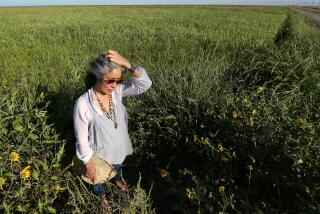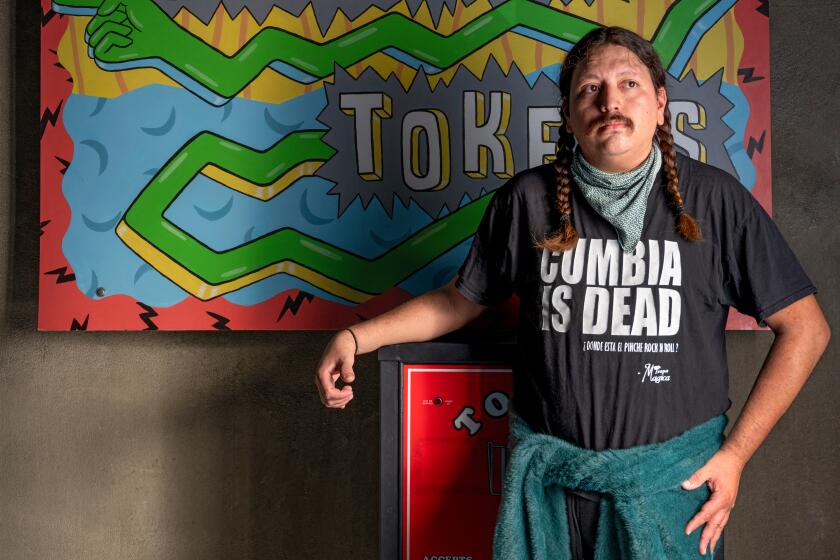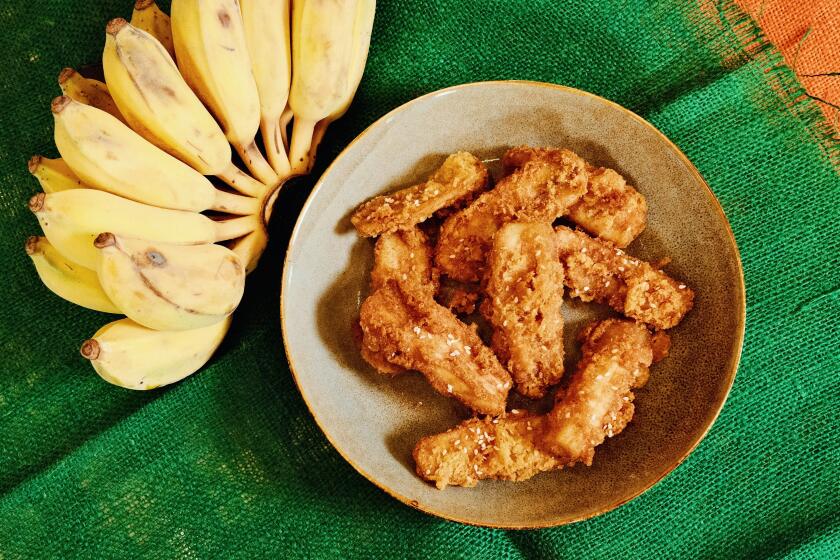Brewing premium sake on Sado Island
Reporting from Niigata, Japan — — At the Obata Brewery on Sado Island, the creamy mash in the large vats is in various stages of fermentation. One batch looks like a giant puffy bud that is about to bloom. Others are more fluid, but occasionally a lava-like bubble pops on the surface, giving off fragrant notes of melon, strawberry and even banana. These vats contain moromi, the fermenting mash of rice, water, yeast and koji mold that will eventually turn into sake.
Although ordinary sake is in most cases mass-produced in automated plants where machines take the place of humans, premium sake, tokutei meishoshu, is another story. It makes up only 25% of the sake produced in Japan and can be hard to find, as some premium sakes are made in small quantities by micro-brewers.
There are strict standards to qualify for premium grade. The determining factor is the quality of the rice, particularly how much it is polished or milled. The more polished the rice, the lighter, more delicate, fragrant and mellower the sake will be. To achieve these qualities, vastly different efforts in brewing are required, many of which cannot be left to the robots.
The brewing must be done mostly by hand, the traditional way. If you ask sake experts to name the crucial element to making premium-grade sake, they will most likely say “people” — in particular, the skill and instincts of the brew master.
The brew master, or toji, at this sake house is young Kenya Kudo, and at this tricky time of year he moves into the brewery so he can keep an eye on the mash around the clock. His house is only a stone’s throw away, so he goes home every day to see his family, eat a home-cooked meal and take a bath — but he always returns to the brewery at night.
Timing is everything in sake-making. Fermentation in the vats can take 18 to 35 days, depending on the temperature and other variables. Ultimately, it’s up to the brew master to decide when to press the mash to produce the liquid that becomes sake.
As far back as he can remember, Kudo wanted to be a shokunin, an artisan who works with his hands. He liked to drink sake and while still in college heard that artisanal breweries were suffering because of a shortage of young people, so he thought he could be a brewer.
When Kudo started investigating, he focused on Niigata, where the many sunny days in the summer for growing rice, and the low temperatures in winter for brewing, are just about perfect. The region has the largest concentration of jizake — regional micro-breweries — in Japan. He applied to the Niigata Sake Brewers Assn. for an entry-level position as a brewer.
Kudo got a call back from Shunichi Obata, the owner of the 120-year-old brewery on Sado Island. Obata produces 120,000 bottles of sake a year. Compared with a commercial brewery, its yield is small. (Some of the national brands produce up to 30 million bottles a year.) Despite Obata’s size, its sales in the United States are growing. Obata is imported by Kura Selections and Niigata Sake Selections, and its Manotsuru sake can be found in Los Angeles at the Wine House.
Obata initially turned him down, but not because he failed the interview. Instead, the owner advised the young man to consider carefully the remoteness of the island (two hours by ferry from the city of Niigata ). Kudo visited a few other breweries in the region, but he had a hunch that Obata was the right place for him. It was a small brewery where he could learn the skills of brewing faster than at a larger place where more of the tasks might be automated.
So he went to work for Obata, apprenticing under veteran brewer Maho Matsui. Kudo’s good instincts and hard work paid off sooner than expected, and at the age of 29, he was promoted to toji, brew master at Obata. Since then he has dedicated his efforts to making premium-grade sakes, including the award-winning Manotsuru “Maho” Daiginjo, which is named after his old master.
A typical day at the brewery begins early with the preparation of the raw materials, specifically washing and soaking the rice. Seven young men, kurabito, comprise Kudo’s brewing team. Shallow vats are filled with water, which is pumped from the well 230 feet below. The soft water of the Niigata region is said to make particularly good sake. The concrete floor of the brewery is wet and slippery. Temperatures in the brewery hover in the low 40s, about the same as outside.
The rice used is a variety grown specifically for brewing sake. Although table rice is edible, sake rice isn’t. With sake rice, much of the outer, flavorful and nutritious part of the grain gets polished away, leaving mostly the starch for the brewer to use. The kernels that have gone through such slow but repeated polishing are dry and absorb water much faster than would a whole grain such as brown rice.
One of the factors that determines whether a sake is premium or ordinary grade is the degree of rice polishing. Within the premium-grade sake that Kudo produces, ginjo-style sakes have 40% or more of each grain ground away. Daiginjo-style sake has a polishing ratio of 50% or more. Obata’s Manotsuru “Maho” Daiginjo has an even higher polishing ratio — 65% of the grain is stripped away, which leaves the sake with a clean, fresh, fruity aroma with notes of anise. Sakes made from less-polished rice tend to have earthier flavors. Which you prefer is a matter of taste.
When Kudo takes out the stopwatch and says “Go,” the men immediately submerge sacks of rice in the water. No one moves except Kudo, who squats down with a wooden paddle to check how much water the rice has absorbed. If he misjudges the soaking time, even by a few seconds, it can affect the quality of the rice, and in turn jeopardize the rest of the brewing process.
Kudo must pay attention to the temperature of the water, the quality of the polished rice and the amount of washing or soaking it has undergone, in order to avoid any cracking of the grains. When Kudo signals the men to lift the rice out of the water, they do it in unison and transfer the rice to a conveyer belt, where it is prepared for steaming. It is like watching a carefully choreographed dance.
When the steaming is completed, the men shovel out the rice by hand and spread it out on a flat surface. Part of the rice is taken to a room that is kept hot and humid, with temperatures around 86 degrees. It is said that this koji-muro is the heart of brewing. This is where the koji mold that helps ferment the rice is grown. Kudo measures and sprinkles the spores over the steamed rice and kneads them in by hand.
The koji converts the rice starch into fermentable sugars, which later serve as food for the yeast cells that turn the sugars into alcohol. The big creamy bloom and bubbles of the moromi are the workings of these microorganisms. They play crucial roles in the brewing process and give sake its flavor and fragrance.
The koji rice is wrapped in blankets and left in the hot muro to incubate. The men come out into the cold brewery again, and divide their chores for the rest of the afternoon. Kudo climbs the ladder that leans against the vat and gives the moromi a gentle poke with a long wooden paddle. It is almost ready to be pressed. Maybe tomorrow.
When evening comes, he will take a short break, go home and have a little sake, which he enjoys pairing with food. He likes talking to his three children and thinking about what they will become when they grow up. Then Kudo will take a nice hot bath, part of his daily ritual. And finally he will go back to the brewery again. Sake is a way of life.
More to Read
Eat your way across L.A.
Get our weekly Tasting Notes newsletter for reviews, news and more.
You may occasionally receive promotional content from the Los Angeles Times.










